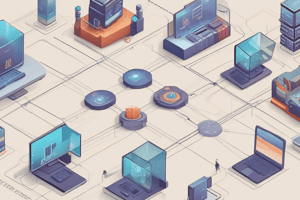Podcast
Questions and Answers
Which layer handles end-to-end connection and ensures reliable message delivery?
Which layer handles end-to-end connection and ensures reliable message delivery?
- Data Link Layer
- Physical Layer
- Transport Layer (correct)
- Session Layer
Which layer establishes, manages, and terminates connections between applications on different hosts?
Which layer establishes, manages, and terminates connections between applications on different hosts?
- Session Layer (correct)
- Network Layer
- Data Link Layer
- Physical Layer
Which layer communicates only with adjacent layers and performs encapsulation?
Which layer communicates only with adjacent layers and performs encapsulation?
- Transport Layer
- Session Layer
- Network Layer (correct)
- Physical Layer
Which protocol is an example of a network layer technology?
Which protocol is an example of a network layer technology?
Which layer provides segmentation, multiplexing, reassembly services, and connection control?
Which layer provides segmentation, multiplexing, reassembly services, and connection control?
Which layer of the OSI model is responsible for routing packets across networks based on logical addresses?
Which layer of the OSI model is responsible for routing packets across networks based on logical addresses?
Which layer of the OSI model deals with the physical transmission of data between devices and includes defining cables, connectors, transmitters, and receivers?
Which layer of the OSI model deals with the physical transmission of data between devices and includes defining cables, connectors, transmitters, and receivers?
In the OSI model, which layer ensures reliable transfer of data frames from one node to another using techniques like error checking and flow control?
In the OSI model, which layer ensures reliable transfer of data frames from one node to another using techniques like error checking and flow control?
Which layer of the OSI model converts raw bits into signals and vice versa?
Which layer of the OSI model converts raw bits into signals and vice versa?
Which layer of the OSI model provides risk-free delivery of data packets to their intended receiver?
Which layer of the OSI model provides risk-free delivery of data packets to their intended receiver?
Flashcards are hidden until you start studying
Study Notes
OSI Model
The Open Systems Interconnection (OSI) model is an abstract framework used by network engineers and computer scientists to understand how different components of a communication system interact with each other. It consists of seven layers, each with its specific functions and protocols. These layers are:
-
Physical Layer: This is the first layer of the OSI model and it deals with the physical transmission of data between devices over a communication channel. It includes defining cables, connectors, transmitters, and receivers. At this layer, raw bits are converted into signals and vice versa.
Example: Ethernet, Wi-Fi, Bluetooth are examples of physical layer technologies.
-
Data Link Layer: The second layer ensures reliable transfer of data frames from one node to another using techniques like error checking, flow control, framing, and accessing media. It provides risk-free delivery of data packets to their intended receiver.
Examples: Ethernet, Point-to-Point Protocol (PPP), Asynchronous Transfer Mode (ATM), Frame Relay, and Token Ring are examples of data link layer technologies.
-
Network Layer: The third layer focuses on routing packets across networks based on their logical addresses. It also provides mechanisms for handling congestion on communication lines and recovering when errors occur.
Example: Internet Protocol (IP), Address Resolution Protocol (ARP), Routing Information Protocol (RIP), and Internet Control Message Protocol (ICMP) are examples of network layer technologies.
-
Transport Layer: The fourth layer handles end-to-end connection, ensuring reliable message delivery through connections. It provides segmentation and reassembly services, multiplexing and demultiplexing, and connection control.
Example: Transmission Control Protocol (TCP), User Datagram Protocol (UDP), Simple Mail Transfer Protocol (SMTP), File Transfer Protocol (FTP), and Remote Procedure Call (RPC) are examples of transport layer technologies.
-
Session Layer: The fifth layer establishes, manages, and terminates connections between applications running on different hosts. In simpler terms, it allows different applications on two computers or systems to communicate with each other.
Example: Secure Sockets Layer (SSL), Secure Shell (SSH), and NetBIOS sessions are examples of session layer technologies.
Each layer communicates only with adjacent layers. For example, the transport layer does not know whether it's talking to a device on its own local network or halfway around the world. The process of translating messages between layers is called encapsulation.
Studying That Suits You
Use AI to generate personalized quizzes and flashcards to suit your learning preferences.





